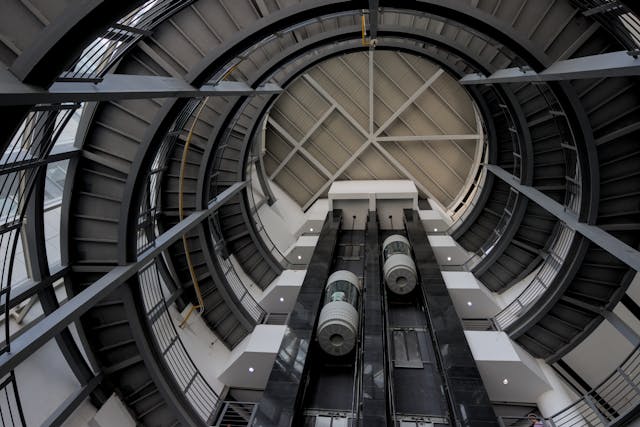
How does an elevator emergency brake work? Modern elevators have an electromagnetic brake that is open when the power is off and the magnet pulls it in so the elevator can move. That way, if the power fails, the brakes will come on and the elevator will stop. Elevators need brakes to stop on each floor, to prevent them from going too high or too low, to slow them down, and to stop them if they fall.
Elevators have technically existed for thousands of years because there has always been a need to hoist things from one level to another. The early elevators were either hoisted by people or by animals, and they were a platform attached to a rope that went through a pulley. If the rope broke, whatever was on the elevator would fall. They weren’t often used for carrying people. It was only with the start of the Industrial Revolution that a proper lifting system became necessary because people suddenly needed to be able to move massive amounts of coal and wood to burn to make steam. The first elevators were powered by steam, and they were installed in coal mines. They were not very safe. Different people invented different kinds of elevators at the start of the nineteenth century, but they were all still only platforms pulled up by different kinds of systems. If the rope broke, the platform would fall. Because of this, they were only used for lifting goods and not people. It was only when Elisha Otis showcased his “safety elevator” that confidence increased, and elevators started to be used in buildings for people. Otis demonstrated his elevator by actually riding on it and cutting the rope. Interestingly, these days, the most expensive apartments in a building are at the top because of the views and their distance away from the noises of the street. Before the elevator was invented, the most expensive apartments were at ground level because people didn’t want to have to climb all the stairs.
The idea behind Otis’s safety elevator is the same idea behind modern elevators’ braking systems, but the technology has changed. The problem with a braking system is that it needs to be triggered, and if an elevator is falling, there isn’t necessarily any power to trigger the system. The logical answer is to have the braking system always on and require power for it to be switched off. That way, if power fails, the braking system automatically triggers. With Otis’s system, there was a spring at the top of the elevator that was attached to two hinged metal bars. On either side of these, there was a metal frame with metal ridges every so often. The top of the spring was attached to the rope of the elevator. The pull of the rope kept pressure on the sprin,g and the two hinged metal bars were always angled inwards, allowing the elevator to ride up and down. If the rope broke, the pressure on the spring was released, the two hinged metal bars would spring outwards, and lodge against the metal ridges on the frame, holding the elevator. The elevator could only fall as far as the closest metal ridge.
Modern elevators have the same system, except that they use electromagnets. The brakes on an elevator are very similar to those on a car. They have brake pads on either side of the elevator frame, on all four corners of the elevator. The brake pads are pushed into the frame with a caliper on a spring. This creates friction and stops the elevator. It is the same as the brakes on your bicycle. An electromagnetic is used to pull the spring and open the brakes so the lift can move. Unlike your bicycle, where the brakes are always open and you have to squeeze them to stop, the brakes on an elevator are always closed, and you have to give them power to open them. That way, if the power in the elevator fails, the brakes will automatically shut. There is also a brake on the rope at the top of the pulley. The machinery at the top of the elevator has a gauge to measure the speed of the rope. If the rope starts moving too quickly, the brakes in the pulley will kick in, stopping it.
What if the elevator falls and the power is still on, but the rope has been severed? All elevators have a safety system for this. It is called the governor, and it can detect how fast the elevator is moving. The governor rotates with the pulley that lifts the elevator. If it starts to spin too quickly, centrifugal force will automatically trigger the braking system, and the elevator will stop. These are separate brakes from the other brakes the elevator has. Most elevators have multiple safety systems.
Let’s say all of these brakes failed for some reason. Would you die? Probably not. Elevators have two final safety mechanisms up their sleeve. This is air resistance and a giant shock absorber at the bottom of the elevator shaft. If the cable holding up the elevator snaps (and there are usually multiple cables), and all of the brakes fail, the elevator would fall down the lift shaft. The brakes might have failed, but they would still be rubbing on the elevator frame, and that would slow down the elevator. Then, air resistance would help. If you jumped off a building, you would reach terminal velocity, but in the elevator shaft, the elevator is compressing the air underneath it, which acts like a cushion. The air cannot escape the shaft fast enough. This will slow down the elevator considerably. Then, right at the bottom, is a giant oil-filled shock absorber, which will catch the elevator and slow it down gradually enough that the people inside should survive. And that is what I learned today.
Sources
https://www.otis.com/en/us/tools-resources/high-rise-safety-systems
https://science.howstuffworks.com/science-vs-myth/everyday-myths/question730.htm
https://science.howstuffworks.com/transport/engines-equipment/elevator6.htm
https://time.com/4700084/elevator-patent-history-otis-safety
https://en.wikipedia.org/wiki/Elevator
Photo by Kampamba : https://www.pexels.com/photo/spiral-staircase-and-elevators-18533100/
